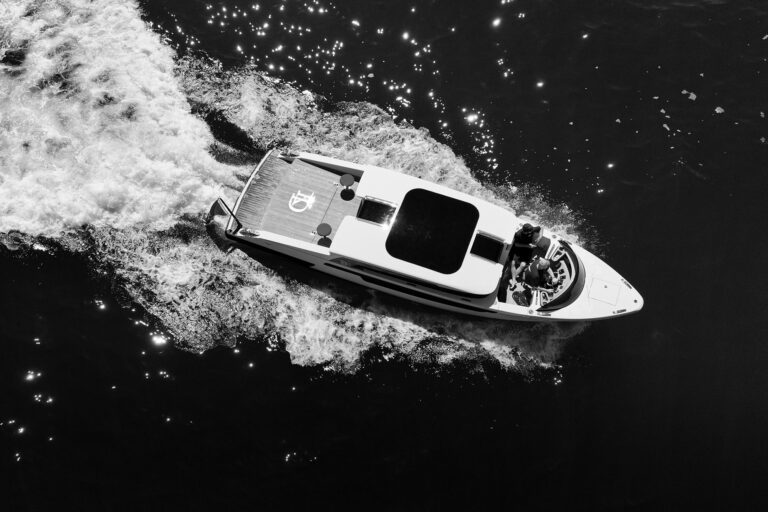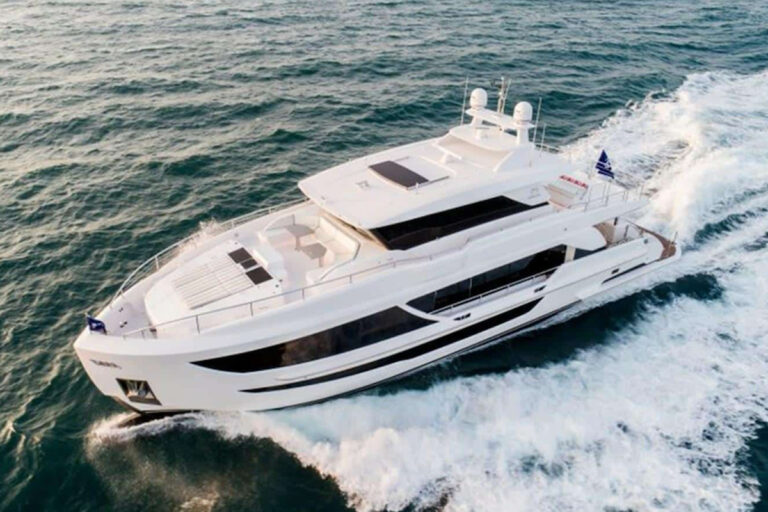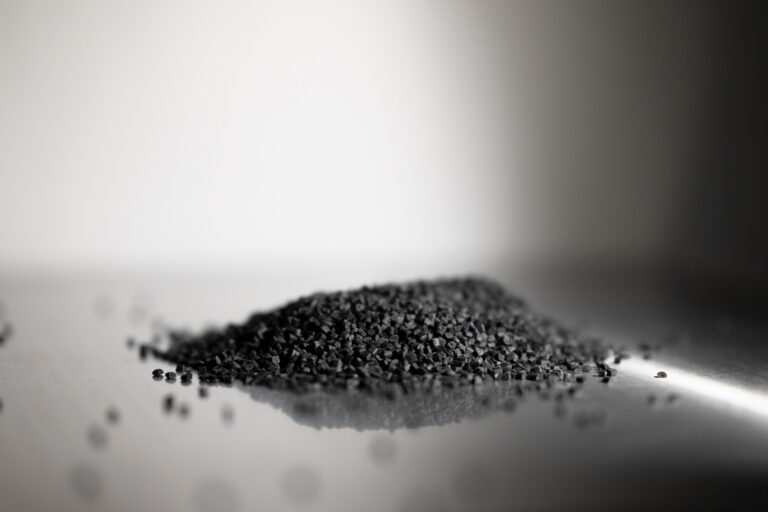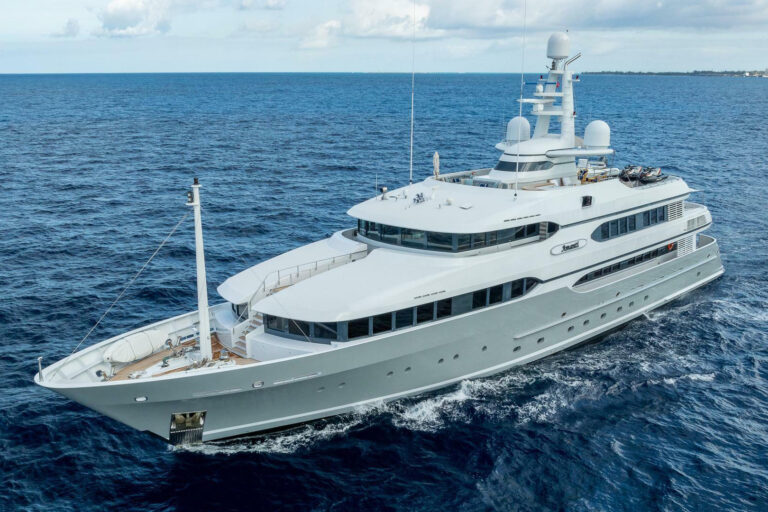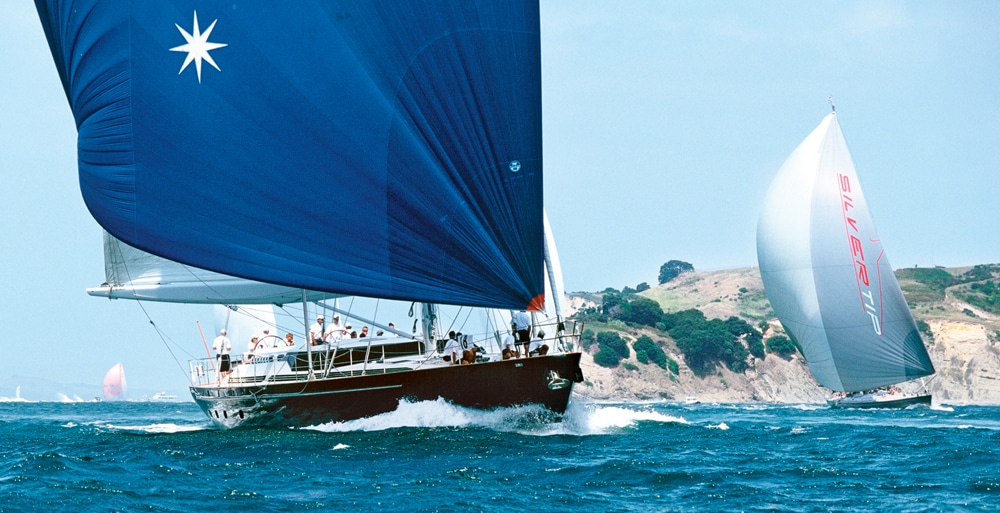
Dubois
Ed Dubois still draws by hand, using battens, splines, weights and curves on a large drawing board.
“I always put my eye down,” he said. “Looking down a five-foot line, you can see what it looks like. You can’t do that on a computer screen.
“When you’re drawing,” Dubois continued, “your mind is working to make your hand move, and it’s a delight. When you’re doing it on the computer, you move the cursor, do whatever you do, and then you press ‘send,’ and the machinery adjusts the line to whatever you want. And in that split second, your mind stops. It’s not doing anything — it’s waiting. It’s intensely boring, I find.”
Dubois freely admits that computers are indispensable in the design of modern yachts, especially the superyachts that make up the vast majority of his firm’s business. The number of calculations, the complexity of the systems and problems inherent in the engineering of the structure would be nearly impossible to do — or at least take a very long time to complete — without the aid of the powerful computers his studio uses. And he tried to adapt.
About 10 years ago, Dubois enrolled in a 10-day computer skills course. “I’d better learn this computer lot,” he told himself. He was in his late 40s at the time. “I got to day three and said, ‘I can’t do this. I just can’t be bothered,’” he said, laughing at the memory.
“Doing anything physical that stretches your mind is deeply satisfying,” Dubois said. “I feel very happy having just designed a set of lines.”
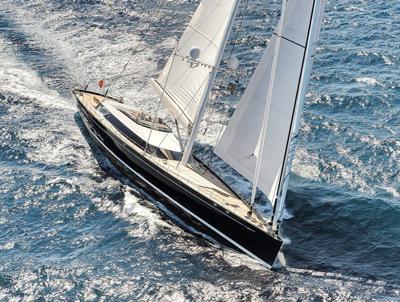
He often goes into the office on Sunday to draw, having worked out the basic shape of a hull during the week. “To do it properly, I need four or five hours’ uninterrupted time to draw that set of lines and get it right. It’s really a nice thing to do — you can listen to some music. …”
Dubois was born in 1952, the third of four children and the only boy in what he described as a typical middle-class English family living in Surrey. His growing up landlocked makes a person wonder how Dubois acquired his love for boats and design. “I think it was innate somehow — I loved boats from an early age.”
Dubois had his first real sailing experience aboard a rented boat on a pond in Regent’s Park, London. “It was just delightful, being propelled by the wind across the water.” When Dubois was 13, his mother enrolled him in a nonprofit camp for boys ages 12 to 18, in southwestern Wales.
“There were no rules,” Dubois said. “You just had to sort of behave normally. I just loved it — I loved every minute there.” He loved sailing so much, he thinks, because he wasn’t as good at traditional sports as the rest of the males from his father’s side of the family, though he enjoyed playing rugby. He also was very musical. “I had a foot in both camps,” he said. “I wanted to be sporty — to be one of the boys — and I also liked the arts.”
One of Dubois’ teachers urged him toward acting, so he auditioned for a part in a local production. When the director called him for a second audition, he didn’t go. “By that time, I just wanted to be a boat designer.” He was 16.
“Part of me thinks I wasn’t very imaginative, because I was set on this one course. On the other hand, it’s really handy if you know what you want to do.” His single-mindedness allowed him to select the courses best suited to his goal. He earned a spot in the boat and yacht design program at Southampton College of Technology, now known as University of Southampton. He entered the program in 1971, a year after its founding. Each year at Southampton comprised three terms, two of 10 weeks each and a third (summer) working in the marine industry. “No one gave you a job. You had to find one.” Dubois got a job with a boatyard on the island of Jersey, one of the Channel Islands off the southern coast of England. There, he worked at building and repairing boats. During this stint, he met a restaurateur who wanted crew to help him deliver his Sparkman & Stephens-designed 31-foot sailboat from Southampton to Jersey. That trip, in bad weather, earned a spot for Dubois on the owner’s regular crew.
The following summer, he landed a job with designer/engineer Alan Buchanan. Buchanan had been a stress engineer with an aircraft manufacturer and had decided to apply his engineering expertise to yacht design. After Dubois graduated from Southampton, he returned to Buchanan’s firm as a qualified naval architect. As one of four full-time members of the staff, Dubois had a lot of responsibility designing production boats. He also worked on the design of an 80-footer named Anaconda, a foam-sandwich yacht built in Australia.
Dubois soon grew tired of tiny Jersey and applied to S&S. The firm accepted his application, but he had to wait 10 months to get a green card to work in the United States — much too long a wait as far as Dubois was concerned. He left Jersey and got a job as a journalist with Yachts & Yachting, a fortnightly on the Thames estuary. As a journalist, Dubois met a lot of people in the marine industry, John Oakley among them. He was the helmsman aboard the 1974 America’s Cup boat Southern Cross and a principal in the Miller and Whitworth sail loft in Australia. (The Miller of this duo was Bob, who designed Southern Cross.) At the time, Oakley ran the loft. He asked Dubois to design boats for him, and they started a branch of Miller and Whitworth in the United Kingdom.
Miller disappeared from the yacht-design scene a short while after the poor showing of Southern Cross, but he earned international acclaim in 1983, when his Australia II won the America’s Cup, defeating Dennis Conner aboard Liberty. By that time, he had changed his name to Ben Lexcen, and the wing keel he drew for Australia II influenced the design of keels throughout the remainder of the 20th century.
Dubois’ first client in his new role at Miller and Whitworth was the restaurateur who owned the S&S 31. The boat was Borsalino Trois, a 34-foot, three-quarter-ton racing yacht. “A good design badly sailed is not a good thing,” Dubois said, so he arranged a meeting between the client and Oakley. Oakley became the helmsman.
The summer of 1976 in England was unusually dry, hot and plagued with light winds. As luck would have it, Dubois’ newly built race boat was especially fast in light air and won the British Trials for the Three Quarter Ton Cup. Luck intervened again. When the regatta began, the weather patterns had changed, the wind blew, and Dubois’ design performed poorly. “I considered shooting myself,” Dubois said through a hearty laugh, “but we’d done enough to get noticed.” Indeed.
More success followed. Dubois won contracts to design a boat for the Three Quarter Ton, Half Ton and Quarter Ton classes. A client in Hong Kong commissioned a boat for the 1977 Admiral’s Cup Championship. This Three Quarter Ton boat won its class championship in 1977. “I sorted out the heavy-air performance and maintained the light-air performance,” Dubois said. “You learn very quickly.” Dubois knew by the end of the 1977 racing season that his design business could sustain itself, separate from the Miller and Whitworth sailmaking company. He and Oakley went their separate ways.
During the 1970s and 1980s, designing successful racing boats was the best way to make a reputation and increase the flow of work. Doug Peterson and Ron Holland were among the most successful designers of that era. “I wanted to be in that camp,” Dubois said, “and just about managed to do that. I was horribly driven.”
His big break came in 1979, surfing on the wake of the 42-foot two-tonner Police Car. Inspired by Wave Rider, a Laurie Davidson design that won the Half Ton Cup in 1978, Police Car was on the Australian Admiral’s Cup team and won the championship in 1979. It had a fractional rig and relatively low freeboard. Every other boat in the two-ton fleet had a masthead rig and a lot more freeboard. “That was a big risk,” Dubois said, but it paid off. “It was just electric in a breeze.”
The day after the tragic Fastnet Race of 1979 ended (15 sailors died in that stormy event), Dubois went to the docks and walked off with six months’ worth of work. “It was a weird feeling,” he said. “Part of me was extremely happy and elated. I knew I was off and running careerwise, but I also knew that there were families who lost people, going through hell.”
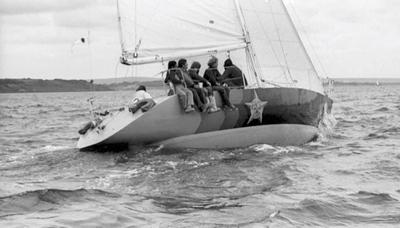
Although drawing leading-edge racing yachts was a good way to establish a designer’s credibility, it was risky. The real security lay in drawing production boats and custom cruising yachts. In 1978, Westerly Yachts hired Dubois to design a line of production boats, earning for him a steady flow of royalties. “That and Police Car got me going properly.”
Six years after Police Car won the Admiral’s Cup championship, Dubois got another break, one that would shape the future of his design firm and establish his credentials in the rarefied atmosphere of the superyacht (a term that Dubois doesn’t like but has learned to accept).
Bob Milhous, an American sailor, had begun casting about for someone to design a big boat. Based on Dubois’ reputation for careful engineering, Milhous commissioned him to design a 37-meter cruising sloop, and he pushed Dubois to produce a yacht that would differ from every other in its size range. Milhous found a yard in New Zealand, which built the hull of aluminum and the superstructure of fiberglass. He christened her Aquel II. “It was pretty space-age at the time,” Dubois said, meaning technically and aesthetically.
Dubois’ plan for the interior influenced the exterior styling. “What we tried to do with Aquel was get the sight lines organized so that when you’re in the boat, you can still see the horizon.” He accomplished his mission by designing a relatively tall trunk cabin with windows along each side and placing the salon in a raised structure atop the trunk cabin. “I thought Aquel II was so different and so interesting that people would sign up straight away, but they didn’t.” A couple of years later, though, Neville Crighton saw Aquel II and thought she was terrific. He commissioned Dubois to design Esprit, which Alloy Yachts built.
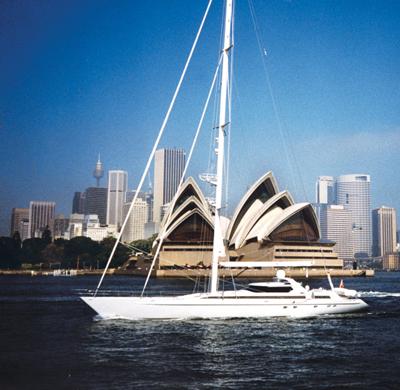
The design of Aquel II also planted the seed that would grow into the Dubois style. “I’m very keen to follow a trend and create a marque…to have a recognizable style,” he said. “It doesn’t suit everybody, and we have lost one or two orders.” Studying the designs that followed Aquel II shows a definite progression from a bulky superstructure to the current flowing, almost organic shapes.
Establishing a distinctive style, however, does not mean that Dubois imposes his tastes on the client. “My job is not to have some ego fancy of what you should have, Mr. Client. I try to find out from the owner what really suits his style of living on the boat — how he spends his time, what his priorities are, and his friends and family — and put the right boat around them. The architecture gives you what you want on the water. It’s a lifestyle. It’s not just the look; it’s how it works.”
Dubois has enjoyed his artistic progression, and his style likely will change subtly as he grows. “I have to say that I get as much fun out of designing boats to look good as I do out of getting them to sail well. I’ve always been like that, even in the racing boats. I always got a buzz out of making them look right. We get work because people like the look.”
Indeed.
Dubois Naval Architects Ltd., +44-1590-626-66; www.duboisyachts.com
Meet Ed Dubois
The naval architect reveals his personal side.
Music: “I love classical music. I was brought up with classical music in the house the whole time.”
Movies: “Any type of movie, except for horror movies and violent movies. Some of the costume dramas are brilliant. I used to be a bit of a film buff as a young man, and I went to see all of [François] Truffaut’s movies. I thought he was brilliant — his understanding of humanity and the frailty of love.” Among his top picks: An Education, Lawrence of Arabia (“I saw it again recently. It’s a brilliant movie…just unbelievable.”) and Cinema Paradiso. (“It’s an Italian movie, and it’s just adorable.”)
Food: “I like all types of food.” pressed for a most favorite — “Italian, I suppose.”
Sports: Rugby. “I used to be quite a fan of the English rugby team, until they lost their way.” and cricket. “Typically English, I do find the game of cricket extraordinary. The concentration to win a five-day match is very intense.”
His designs: “I did fall in love with Imagine a bit.” Launched in 1993, she was the third yacht he had done with alloy.





